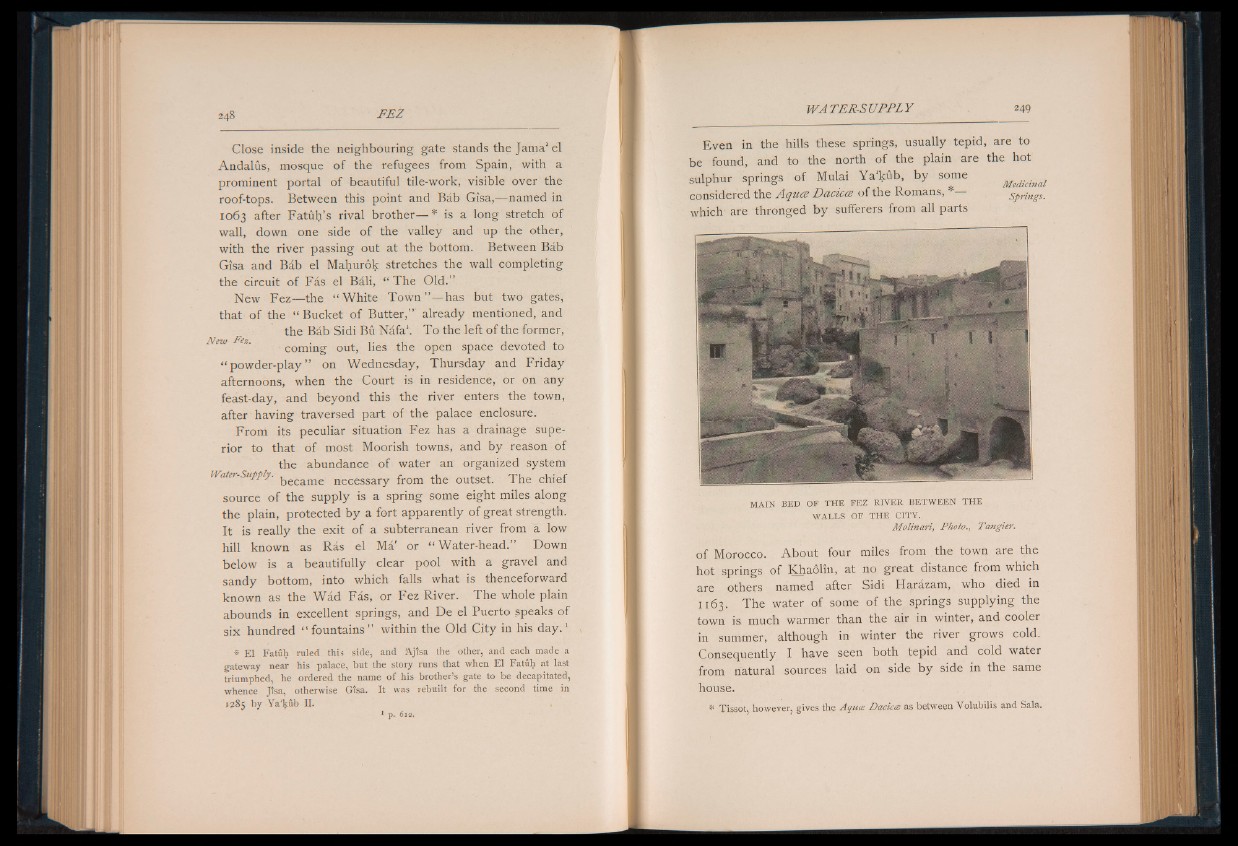
Close inside the neighbouring gate stands the Jama1 el
Andalus, mosque o f the refugees from Spain, with a
prominent portal of beautiful tile-work, visible over the
roof-tops. Between this point and Bab Gisa,— named in
1063 after Fatuh’s rival brother— * is a long stretch of
wall, down one side of the valley and up the other,
with the river passing out at the bottom. Between Bab
Gisa and Bab el Mahurok stretches the wall completing
the circuit of Fas el Bali, “ The Old.”
New Fez— the “ White Town ’’— has but two gates,
that of the “ Bucket of Butter,” already mentioned, and
the Bab Sidi Bu Nafa’. To the left of the former,
coming out, lies the open space devoted to
“ powder-play ” on Wednesday, Thursday and Friday
afternoons, when the Court is in residence, or on any
feast-day, and beyond this the river enters the town,
after having traversed part of the palace enclosure.
From its peculiar situation Fez has a drainage superior
to that of most Moorish towns, and by reason of
the abundance of water an organized system
Water-Supply. k e c am e necessary from the outset. The chief
source o f the supply is a spring some eight miles along
the plain, protected by a fort apparently of great strength.
It is really the exit of a subterranean river from a low
hill known as Ras el Ma or “ Water-head.” Down
below is a beautifully clear pool with a gravel and
sandy bottom, into which falls what is thenceforward
known as the Wad Fas, or Fez River. The whole plain
abounds in excellent springs, and De el Puerto speaks of
six hundred “ fountains” within the Old City in his d a y .1
* El Fatuh ruled this side, and Ajtsa the other, and each made a
gateway near his palace, but the story runs that when El Fatuh at last
triumphed, he ordered the name of his brother’s gate to be decapitated,
whence Jisa, otherwise Gisa. It was rebuilt for the second time in
1285 by Ya’kub II.
1 p . 6 l 2 ,
Even in the hills these springs, usually tepid, are to
be found, and to the north of the plain are the hot
sulphur springs of Mulai Y a ’kub, by some Medicinai
considered the Aquce Dacictz of the Romans, *— springs.
which are thronged by sufferers from all parts
MAIN BED OF THE FEZ RIV ER BETWE EN THE
W A LLS OF TH E C IT Y ,
Molinari, Photo., Tangier.
of Morocco. About four miles from the town are the
hot springs of Khaolin, at no great distance from which
are others named after Sidi Harazam, who died in
1163. The water of some of the springs supplying the
town is much warmer than the air in winter, and cooler
in summer, although in winter the river grows cold.
Consequently I have seen both tepid and cold water
from natural sources laid on side by side in the same
house.
• Tissot, however, gives the Aquce Dacicce as between Volubilis and Sala.